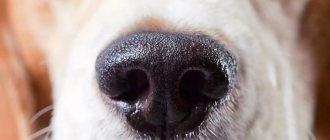Dog owners know very well that if their pet is feeling well, his nose should be cold and wet. The first sign that something is wrong with the dog is a dry and hot nose. Is it always worth worrying about this, and what reasons can cause dry nose?
First, a few physiological aspects. Most pets have a mucus-covered nose, both inside and out. This mucus is produced by special glands and is an assistant that helps determine air movement. The moisture covering the top of the olfactory organ helps the dog detect odors. If you want, this is a kind of barometer of smell.
Features of the structure of the nose in dogs
It has long been noted that a dog’s nose should be moist and cool. The moisture in the nose is ensured by the constant secretion of special mucus, which is evenly distributed throughout the animal's nasal mucosa. The main purpose of this lubricant is to form a special filter, invented by nature, with the help of which the dog distinguishes odors much better.
If the nose dries out, the ability to better distinguish odors is lost. In wild living conditions, this can have dire consequences: it did not recognize the prey, did not eat on time, fell ill, or died. Fortunately, most dogs on planet Earth do not face such a fate, since people themselves find food for their younger brothers, completely ensuring their survival.
Science claims that a dog's wet nose increases the ability to distinguish odors several times, to accurately recognize where they came from, and to separate the overall smell into its constituent components. The nose, like the tongue, is a thermostat, one of the organs for maintaining constant balance in the animal’s body.
When you need to urgently take a patient to a veterinary clinic
The only accurate way to determine if your dog has a fever is to take his rectal temperature.
Experts recommend using a digital thermometer specifically designed for rectal use in dogs. Most thermometers designed for use in the human ear are not suitable for this purpose.
To take your dog's temperature, first coat the thermometer with a lubricant such as petroleum gel or baby oil. Then carefully insert the thermometer one to two centimeters into your dog's anus and wait for the results. Most thermometers will take less than 60 seconds to register for this purpose. You can also use a mercury thermometer, but you need to measure for at least 5 minutes.
Causes of a warm nose in a dog
It’s worth noting right away that a dog’s dry nose does not necessarily indicate the presence of health problems. Experienced dog breeders say that if a dog has a dry and warm nose, this may indicate:
Temporary dehydration of the body. This problem is easily solved. The owner should place a bowl of clean water within reach. Considering that dogs often eat bones, water is vital for them, as it is actively used to create digestive juices for digesting heavy food.
Temperature extremes (high, low). The animal does not have time to adapt to weather conditions, which leads to temporary drying of the mucous surface of the dog’s nose. As soon as the weather returns to normal, the natural state of the dog’s nose will also return to normal;
Natural state of a dog. If from a very young age the dog had a tendency to have a dry, warm nose, this does not mean that it was sick. This is especially true for small individuals;
The beautiful creature has just woken up. Veterinarians say that during sleep, the dog’s body heats up intensely, which leads to drying of the nasal mucosa not only on visible surfaces, but also inside. After the pet gets up, runs a little, drinks some water, scratches itself, the nose will quickly return to normal. To summarize, we can say that if you notice that your pet’s nose has dried up, but his behavior is still characterized by the same cheerfulness and ease, then there is no reason to worry.
When should you pay special attention to your dog's health?
Unfortunately, quite often a hot nose is observed in a pet during illness. This includes literally all conditions accompanied by fever and dehydration. But, you need to remember that in this case, dry nose is not the only painful symptom. Usually it is accompanied by other, no less striking signs, indicating the nature of the pathology and the severity of the course. The main ones are:
- lack of appetite and sometimes thirst;
- increased thirst;
- excessive lethargy, refusal to play;
- the desire to go into the darkness, to hide from communication;
- aggression, irritation;
- peeling and cracking of the nasal mucosa, rash around the nostrils;
- nasal discharge - thin or thick, greenish;
- lacrimation, photophobia, sneezing, cough;
- rapid breathing and heart rate;
- signs of fever (over 39 degrees);
- dull matted wool;
- constant skin itching;
- hair loss, bald patches.
The dog should be monitored. If these symptoms increase and the dog feels worse and worse, you should immediately take it to the veterinarian.
There is also a group of signs indicating a dog’s critical condition. When they appear, the animal requires urgent help. If your dog has a dry nose and exhibits one or more of the following signs, he may be saved by taking him to a veterinarian immediately:
- rise in body temperature to a level exceeding 40 degrees;
- lethargy, loss of consciousness;
- the presence of seizures or paresis;
- problems of the gastrointestinal tract (vomiting, diarrhea mixed with blood);
- urinating too often or too rarely;
- inappropriate behavior (strong aggression, fear of hydrophobia, walking in circles);
- pain syndrome (moans, whining).
When should you worry about your dog's nose?
So, we have already looked at some of the reasons why a dog has a warm and dry nose. If the desiccation of an organ is accompanied by lethargy, apathy, and loss of appetite, you should start to worry, since this may indicate an imbalance in the animal’s body. It can be:
- a variety of allergic reactions;
- injuries received;
- problems with the digestive system, including parasitosis;
- the onset of a cold;
- development of pemphigus.
Allergy
Just like in humans, allergies in dogs are quite common. The dog reacts very sharply to incorrectly selected food, a sudden change in the usual diet, the use of cheap plastic plates that contaminate food with toxins, poor-quality bedding, the presence of strong aromatic substances in the air, and plant pollen.
Often an allergy indicates the presence of worms that need to be gotten rid of; fortunately, the arsenal of modern medicine for treating this scourge is extremely wide. The absence of parasites is not only a guarantee of good health for a furry domestic animal, but also confidence that its worms will not move into the owner, which can be very dangerous, especially if you catch echinococcus, which can cause the death of the dog owner.
For obvious reasons, you should not immediately put your pet on antihistamines, which will bring little benefit. It is better to systematically and purposefully look for the cause of acute reactions that indicate trouble. Dog handlers advise not to use plastic bowls, especially for water, to construct bedding from natural fabrics with minimal use of dyes, and to observe how the dog reacts to this or that food.
Injuries
The inflammatory process due to injury can also dry out the dog's nose. In this case, there will be a reluctance to move, a tendency to rest frequently, drowsiness, lameness and other symptoms. In this case, you need to provide your pet with quality rest for a while, allowing him to regain his strength.
Infections
If your dog has a warm, moist nose, this may indicate the presence of an infectious disease. Measuring your temperature can confirm your guess, especially if it is above 39 degrees. If it is clear that the dog has contracted an unpleasant disease, you need to look for the cause that caused it, go to the veterinarian, who can choose the right treatment, improve the diet, making it natural and as varied as possible. When poor health is accompanied by signs of diarrhea and vomiting, the nose will become not only dry, but also very hot due to lack of fluid in the body.
Cold
Some people don’t even realize that dogs can catch a cold, especially if they have to sleep in a room where there are constant drafts and no basic heating. In this case, the nose will be dry and cold. In this case, phenomena such as periodic sneezing, coughing, wheezing during breathing, snoring during sleep (due to nasal congestion), muscle tremors (increased body temperature) will be observed. In such cases, it is worth reducing the calorie intake, ensuring easy access to water, keeping the pet in a warm, dry room, and temporarily limiting walks in cold air.
Pemphigus
Sometimes your pet's nose becomes dry and covered with crusts that fall off. Small blisters constantly form, which open on their own, and new ones appear in their place. This unpleasant symptom indicates that the dog is developing a disease associated with disruption of the proper functioning of the immune system - pemphigus. It is unlikely that you will be able to cope with it on your own without professional help; you should go to the veterinarian.
Other serious diseases
A warm nose may also indicate the development of distemper and even rabies. But you shouldn’t make such diagnoses right away. These diseases have very clear symptoms, when the dog refuses food, staggers, falls on its side from weakness, and pus is discharged from the nose and eyes. And with rabies, the pet will look for a secluded place for complete privacy, and will react sharply to light and the presence of people.
How to treat such symptoms?
Only a doctor can treat unpleasant symptoms; he will conduct an examination, take tests and determine the cause of poor health. The clinical picture often includes an increase in temperature, hence a dry and hot nose is an indicator of the disease.
Treatment tactics may be as follows:
- In case of allergic reactions, it is necessary to protect the animal from the pathogen. If you don’t know what the body reacted to, think about what has changed in the near future: care products, food, bedding, etc. For the dog, choose metal or glass dishes, a cotton bed, or if it’s a blanket, then a cotton one. It is advisable not to use strong chemicals to clean the floor; there should be no fragrances in the room. If the condition is accompanied by itching, buy an antihistamine at the pharmacy and give it to your dog before visiting the veterinarian. A specialist will take allergy tests.
- Temperature after vaccination. The vaccine can cause an increase in temperature up to 39 degrees, while the dog feels normal, then no treatment is required, everything will return to normal in 2-3 days. If the indicator is higher, the pet is trembling, refuses to eat, and excessive salivation appears, give him an allergy medicine and take him to the clinic.
- Colds are treated by drinking plenty of fluids and resting. If the condition does not change or worsens within 48-72 hours, treatment should be prescribed. Severe wheezing and cough are indications for the use of medical, often antibacterial, drugs.
- Pemphigus is treated with a course of medications that suppress the immune system. This group of medications has a large number of side effects, however, without them, the animal’s internal organs may fail. All therapy is carried out on an outpatient basis.
- Intoxication of the body. Much depends on the condition of the animal and the cause of poisoning. For eating disorders, you can help by taking absorbents and activated carbon (1 tablet per 10 kg of body weight). If vomiting and diarrhea last more than 2 days, it is necessary to give rehydrating agents, they will restore water balance. If poisoning with toxic substances occurs and the reaction is immediate, then induce vomiting with a solution of potassium permanganate, call an ambulance.
- After a tick bite, the pet is taken to the veterinarian, it is necessary to understand the type of pathogen, and symptomatic therapy is carried out. If you find an insect on your dog, do not hesitate, some forms of infection are fatal.
- Damage to the surface of the nose due to weather conditions is treated with healing or moisturizing ointments. In both hot and cold weather, it is advisable to shorten the walking time until the wounds are completely healed.
Since the most common illness that causes a dry and hot nose is a cold, we will tell you in more detail how to treat it. In most cases, this can be done at home. So, you understand that the dog has a fever (hot ears, dry nose), red tongue, nasal discharge, coughing, wheezing. The dog is shivering.
To help the animal, follow the general recommendations:
- Increase the amount of water and lighten your diet. Remove difficult-to-digest meat from it, add more vegetables, or offer soup.
- Leave small breeds at home; walk large dogs for a minimum amount of time.
- Make sure there are no drafts in the room. Set up a warm sleeping place.
- When trembling, you can comb or rub your pet, this accelerates the blood and increases the tone of the body.
It is not recommended to choose medications on your own; however, the following medications are considered safe:
- Gamavit subcutaneously or intramuscularly 2 times a day, course 3-5 days.
- Cycloferon is an antiviral agent that strengthens the immune system and prevents the spread of the virus. You can give injections or give tablets, the dose depends on the weight of the individual, the average duration of use is 5 days.
- Amoxiclav. The amount of the drug is prescribed based on the size of the animal, 1/4 tablet per 5 kg every 12 hours. Course according to instructions.
- Diphenhydramine is used as an antipyretic.
Reducing the temperature with paracetamol-based products is strictly prohibited.
This substance is toxic to animals. To facilitate the discharge of sputum, decoctions of herbs are used: licorice, plantain, coltsfoot. If the condition does not improve, the doctor prescribes antibiotics. Among the frequently used ones: Vilprafen, Dorin, Matiet-forte.
If a cold is accompanied by rhinitis or conjunctivitis, the nose is wet, the eyes are watery, you need to wash them and rid them of excess mucus. Bathing the animal during this period is prohibited.
Video: Why does my dog have a hot, wet nose and rapid breathing?
General recommendations
So, every dog owner should understand that if the dog’s nose is dry and hot, you should not immediately run to the veterinarian. You just need to carefully observe the behavior of your ward. If the behavior does not change, the animal is active and mobile, eats with appetite, then there is nothing to worry about. If deviations in the condition of the nose are accompanied by a pronounced change in the physiological balance of the animal, then it is worth looking for the reason that caused it, calling on the professional experience of a veterinarian to help. He will help make the correct diagnosis and prescribe the correct treatment.
In order for your pet to always be in excellent condition, you need to regularly perform the same actions: avoid dehydration, diversify the menu, regularly walk it, clean it from parasites every quarter. It is important not to use hygiene products that can cause an allergic reaction, to maintain optimal temperature conditions for living (so that it is neither too cold nor too hot), and if the inflammatory process begins, immediately seek medical help.
Currently reading:
- 6 Factors for a Cold or Wet Dog's Nose
- Seven Signs and Remedies for Getting Rid of Fleas in Dogs
- How and with what to treat a runny nose or rhinitis in dogs
- Tips for proper dog burial
In what cases should you immediately contact the clinic?
Throughout the entire article, we have repeatedly emphasized that you will still have to call a veterinarian to see your pet. But here are the cases in which you need to immediately contact the clinic:
- If the pet lies flat and does not react to anything at all.
- Refusal of water. A short-term (up to 12 hours) hunger strike is allowed, since it is not so dangerous for the puppy’s life.
- Apathy, strange behavior of the animal. These signs may indicate serious infections and central nervous system damage.
- Hoarse, heavy and intermittent breathing. This is how severe upper respiratory tract diseases manifest themselves.
Home care and when to call the vet
If your dog has a temperature above 39, you should call your veterinarian. Fever above 40 is an emergency that must be addressed promptly.
If your dog has a temperature above 100 degrees Fahrenheit, you can lower his body temperature by running cool water on his fur, especially around the ears and paws.
Using a fan on damp wool will help reduce the temperature. When doing this, be sure to monitor your dog's rectal temperature and stop the cooling procedure when it reaches 39.5. You should not lower the temperature too quickly.
If your dog has a fever, try to make sure he drinks enough water regularly to stay hydrated, but don't force it. And never give your dog medications meant to reduce fever, such as acetaminophen or ibuprofen, as these can be poisonous to dogs and cause serious stomach, liver and kidney damage or death.
^Top
What should the owner do?
If you find that your pet's nose is warm and dry, don't panic. Monitor the dog’s behavior – does it have an appetite, is it active. If the dog behaves normally, he is healthy, and the dryness will soon go away. If his nose remains warm for a long time and his health worsens, measure his body temperature. If the temperature is above 38.5 degrees, take your pet to the veterinarian. If the temperature has exceeded 40 degrees, it should first be brought down, and only then go to the veterinarian.
If your pet has other signs of illness besides a dry nose, do not delay a visit to the clinic. The sooner you start treating your dog, the faster your pet’s condition will return to normal.











